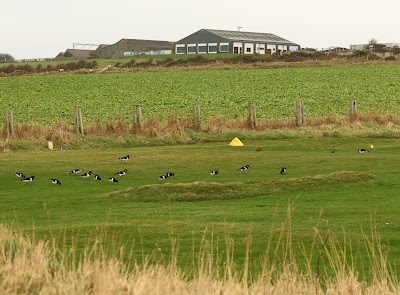December and a first for Wales..
Record of the week for the West Wales Biodiversity Information Centre in the middle of December came from Cardigan, a new Fungi for Wales.
Found by Yusef Samari who organises weekly nature walks around Cardigan and identified by County Recorder, Steve Chambers. They were out surveying a small woodland and found it on a fallen branch with a large leafy lichen (Ramalina fraxinea), which was covered in an orange/pink lichenicolous fungus. Lichenicolous fungi are a group of fungi that live exclusively on lichens. This one turned out to be Tremella ramalinae, the first record of this species in Wales.
Some birds recorded this December were species not regularly seen. On the 12th, the previously reported Red-throated Diver, Great Crested Grebe and female Red-breasted Merganser were all present around the inner estuary and seen intermittently since.
On the 11th, two Firecrests were near the river view point on the reserve - one we ringed in February this year, our first ever returning site faithful Firecrest. Karen Leah photographed one on the reserve, spotted when going through her photos once home.
 |
| Firecrest with its white eye stripe just visible - Karen Leah |
John Ramm also saw a Firecrest near the boat club at Gwbert on the 11th.
No diving ducks have been recorded this month, Goldeneye numbers have been gradually declining in recent years.
Wigeon numbers are lower with the mild weather but 300 were counted around the estuary for the monthly Wetland Bird Survey for the BTO
 |
| Wigeon - Dyfed James |
94 Oystercatchers were counted for WeBS. On the 23rd in a gale they were feeding on the golf course at The Cliff Hotel. Just over 100 were counted at high tide when they were pushed off the estuary.
 |
| Oystercatchers feeding on the Cliff golf course - Dyfed James |
Up to 3 Goosander together are being seen regularly on the river through the reserve.
White- winged gulls from the north generally start to arrive in small numbers from early January. Often seen in the estuary, sometimes from Curlew Hide on the reserve. An adult Glaucous Gull was present in the estuary on the 16th. Brennig Hughes found an adult Iceland Gull and the highest count this year of Yellow-legged Gulls with 5 seen on the 23rd.
Some records from photographers around the Teifi Marshes. Stonechats aren't seen regularly here so it was nice to see this one from Colin Dalton
The feeding stump in the car park is worth a look particularly as it can be watched from the car in the rain. This Marsh Tit was seen on the 14th
 |
| Marsh Tit - Tommy Evans |
It is also a good place to record colour-ringed Reed Buntings for the Teifi Ringing Group's study of adult survival.
 |
| Reed Bunting - Tommy Evans |
On Saturday 16th December, a Brown Hairstreak egg hunt was carried out at The Welsh Wildlife Centre, Cilgerran coordinated by Paul Taylor. They only covered a relatively small area but found 165 eggs. They also found some Lackey Moth eggs and an Otter footprint. Final results of the egg counts in the area will be detailed in a future blog
 |
| Brown Hairstreak eggs - Paul Taylor |
(Wendy J and Rich D)

